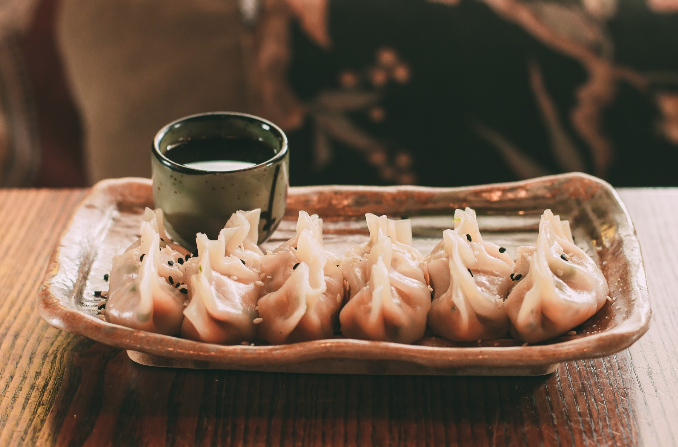Almost every cuisine in the world has it’s own version of dumpling. They all look and taste deliciously different; are usually an integral part of a region’s history; tell a compact story of their lands traditional foods, and can be found everywhere from street stalls to high society restaurants. But it doesn’t stop there.
Around the world we can find dumplings being steamed, grilled, baked, fried, boiled, hidden in stews, added to soups…the list goes on. So how does one qualify as a dumpling?
It’s actually pretty easy: First you need any kind of dough: flour, cornmeal, even starchy vegetables make a good dumpling dough. Then find a filling: sweet, savoury, vegetables, meat; or all of the above if you’re keen on a sweet and sour pork dumpling! Wrap said filling in said dough, decide on how you want to cook your wee bundle of food, and voila! #dumplingheaven
They say food can bring nations together, or divide them. There is one dumpling that has gone the extra mile (you could call it the overachiever of the food group) and done both.
During the worldwide mayhem that was World War 2, the Japanese invaded China (again). Whilst there, the Japanese soldiers were introduced to a delicious and conveniently wrapped food morsel called a jiaozi. The war ended with Japan surrendering and the soldiers retreating from China. Apparently the rule of “take only photographs, leave only footsteps” didn’t apply back then, so the Japanese returned home defeated in war but triumphant in their new knowledge (and probably backpacks stuffed full) of the Chinese dumpling.
And they named him: Gyoza.
Fast forward a few decades and gyoza are well known and loved all over the world. As far as we’re concerned the crescent shaped morsels tenderly wrapped in paper thin dough are the bee’s knees. And Snug Lounge is the perfect place to start your own dumpling love affair!
Maybe you want something to share with your mates over a cold Tiger beer or bespoke Snug Lounge cocktail, or perhaps you’re ‘get your own these are my gyoza!’ type (I belong to the latter group, don’t judge us); either way, there is only one question you need to answer: Steamed or fried? The good news is that there is no right or wrong answer to this question.
Here’s the lowdown on your gyoza:
Steamed Gyoza
Nutrients are preserved better with steam cooking, as are the flavours. The super hot temperatures required to turn water into steam mean your gyoza cooks very fast, which results in a light, juicy dumpling that focuses on the filling as the star ingredient. Try our favourite steamed gyoza recipe here!
Fried Gyoza
Pot-stickers (like fried only better) are just-as-healthy versions of steamed dumplings. The main difference is the steaming happens after the tiny wee things have been browned in a pan for a few minutes. Water is then added to the pan and evaporated, leaving a delectable crispy-chewy bottom, which enhances the flavours of the filling. Here’s an awesome recipe for pot-stickers.
Still not sure what you’d go for? The best way to decide is simply to try them both!

Here are two of our favourite gyoza recipes to get you in the mood.
Steamed: Prawn, Chicken and Garlic Chive Gyoza
Ingredients
20 dumpling wrappers (buy from any asian supermarket)
To serve: brown rice vinegar and sesame seeds
Dumpling filling
400g prawn meat; coarsely chop 200g and fine chop 200g
100g minced chicken
10g garlic chives
¾ tsp sesame oil
¼ caster sugar
½ tsp salt reduced soy sauce
Pinch of white pepper to taste
Directions
- Mix the meat together with the chives, ½ tsp soy sauce and 1 tsp minced garlic
- Spoon one heaped teaspoon onto the centre of each wrapper
- Brush the edges of the wrapper with a little water and fold to enclose. You can try pleating the edges with your fingertips (check out this video for pointers)
- Stand the dumpling up on a tray lined with baking paper and refrigerate til needed
- Line your bamboo steamer with baking paper
- Place the dumplings in your steamer, making sure they don’t touch each other
- Rest your steamer over pot or wok of boiling water and steam 3-4 mins til cooked
Serve with the brown rice vinegar and a sprinkle of sesame seeds. Yum!
Pot sticker: Pork and Ginger
Ingredients
20 dumpling wrappers (buy from any asian supermarket)
1 tbsp light cooking oil (sunflower works well)
100ml water for cooking
To serve: 80mls black vinegar with 1 tbsp finely chopped fresh red chilli
Dumpling filling
200g pork mince
4 spring onions, white and green ends finely chopped
2 tsp finely grated ginger
2 cloves crushed garlic
1 tsp reduced salt soy sauce
Pinch of white pepper to taste
Directions
- Mix together the pork mince, spring onions, ginger and garlic with the soy sauce
- Spoon one heaped teaspoon onto the centre of each wrapper
- Brush the edges with a little water and fold the wrapper to enclose (check out this video for pointers), pleating the edges with your fingertips
- Stand the dumpling on a baking paper lined tray and refrigerate until needed
- Heat the cooking oil over a medium high heat
- Arrange dumplings bottom side down in the pan
- Cook for 2 to 4 minutes until the bottom is golden
- Pour in 100ml water and quickly cover with a tight fitting lid and cook until most of the water is evaporated (around three minutes
- Remove the lid and allow the rest of the water to evaporate
Serve with the dipping sauce. Enjoy!




